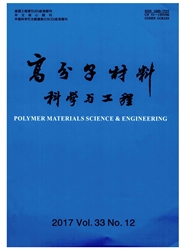

 中文摘要:
中文摘要:
通过直接酰胺化反应,用氨基封端聚乙二醇(H2N-PEG-NH2)对马来酸酐改性聚乳酸(MPLA)进行了本体改性。用红外、核磁和差示扫描技术对改性材料进行了表征,用FITC荧光标记牛血清白蛋白(FITC-BSA)对材料的非特异性吸附进行了检测。结果表明,聚乙二醇被成功地接枝到MPLA上,与聚乳酸(PLA)和MPLA相比,得到的产物(PPLA)明显降低了对牛血清白蛋白的非特异性吸附,仅为PLA的37.3%。
 英文摘要:
英文摘要:
With Maleic anhydride grafted PLA (MPLA) as raw material, a method for covalently grafting polyethylene glycol (PEG) onto MPLA was described, which was the direct reaction of amino group terminated PEG with anhydride groups on MPLA. The product is PPLA. In- frared (IR) and Magnetic resonance imaging (NMR) and differential scanning calorimetry (DSC) were used to characterize PPLA. The anti-non-specific protein absorption property of PLA, MPI.A and PPLA were tested using FITC labeled BSA. The results indicate that PEG is successfully grafted onto MPLA and PPLA has the prominent property of decreasing the non-specific protein absorption, compared with PLA and MPLA. Due to its anti-non-specific absorption ability and many reactive groups in its bulk, it will be a useful raw material for the preparation of bioactive poly(lactic acid) and have a potential use in tissue engineering and drug delivery.
 同期刊论文项目
同期刊论文项目
 同项目期刊论文
同项目期刊论文
 期刊信息
期刊信息
